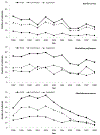Foodborne disease outbreaks caused by Bacillus cereus, Clostridium perfringens, and Staphylococcus aureus--United States, 1998-2008
- PMID: 23592829
- PMCID: PMC11334977
- DOI: 10.1093/cid/cit244
Foodborne disease outbreaks caused by Bacillus cereus, Clostridium perfringens, and Staphylococcus aureus--United States, 1998-2008
Abstract
From 1998 to 2008, 1229 foodborne outbreaks caused by Bacillus cereus, Clostridium perfringens, and Staphylococcus aureus were reported in the United States; 39% were reported with a confirmed etiology. Vomiting was commonly reported in B. cereus (median, 75% of cases) and S. aureus outbreaks (median, 87%), but rarely in C. perfringens outbreaks (median, 9%). Meat or poultry dishes were commonly implicated in C. perfringens (63%) and S. aureus (55%) outbreaks, and rice dishes were commonly implicated in B. cereus outbreaks (50%). Errors in food processing and preparation were commonly reported (93%), regardless of etiology; contamination by a food worker was only common in S. aureus outbreaks (55%). Public health interventions should focus on these commonly reported errors to reduce the occurrence of outbreaks caused by B. cereus, C. perfringens, and S. aureus in the United States.
Keywords: Bacillus cereus; Clostridium perfringens; Staphylococcus aureus; bacterial toxins; disease outbreaks.
Conflict of interest statement
All authors have submitted the ICMJE Form for Disclosure of Potential Conflicts of Interest. Conflicts that the editors consider relevant to the content of the manuscript have been disclosed.
Figures


Similar articles
-
Epidemiology of foodborne disease outbreaks caused by Clostridium perfringens, United States, 1998-2010.Foodborne Pathog Dis. 2013 Feb;10(2):131-6. doi: 10.1089/fpd.2012.1316. Epub 2013 Feb 4. Foodborne Pathog Dis. 2013. PMID: 23379281 Free PMC article.
-
The use of clinical profiles in the investigation of foodborne outbreaks in restaurants: United States, 1982-1997.Epidemiol Infect. 2008 Jan;136(1):65-72. doi: 10.1017/S0950268807008199. Epub 2007 Mar 5. Epidemiol Infect. 2008. PMID: 17335632 Free PMC article.
-
Bacillus cereus as the main casual agent of foodborne outbreaks in Southern Brazil: data from 11 years.Cad Saude Publica. 2018 Mar 29;34(4):e00057417. doi: 10.1590/0102-311X00057417. Cad Saude Publica. 2018. PMID: 29617482
-
Analytical methods for Bacillus cereus and other Bacillus species.Int J Food Microbiol. 1990 Mar;10(2):125-41. doi: 10.1016/0168-1605(90)90061-9. Int J Food Microbiol. 1990. PMID: 2119209 Review.
-
Bacillus cereus food poisoning.Soc Appl Bacteriol Symp Ser. 1976;4:197-213. Soc Appl Bacteriol Symp Ser. 1976. PMID: 179147 Review. No abstract available.
Cited by
-
Pseudomonas Phage ZCPS1 Endolysin as a Potential Therapeutic Agent.Viruses. 2023 Feb 13;15(2):520. doi: 10.3390/v15020520. Viruses. 2023. PMID: 36851734 Free PMC article.
-
Multipathogen Outbreak of Bacillus cereus and Clostridium perfringens Among Hospital Workers in Alaska, August 2021.Public Health Rep. 2024 Mar-Apr;139(2):195-200. doi: 10.1177/00333549231170220. Epub 2023 May 13. Public Health Rep. 2024. PMID: 37178053 Free PMC article.
-
Bacillus cereus Biofilms-Same, Only Different.Front Microbiol. 2016 Jul 7;7:1054. doi: 10.3389/fmicb.2016.01054. eCollection 2016. Front Microbiol. 2016. PMID: 27458448 Free PMC article. Review.
-
New antibacterial-core structures based on styryl quinolinium.Food Sci Biotechnol. 2017 Apr 30;26(2):521-529. doi: 10.1007/s10068-017-0072-8. eCollection 2017. Food Sci Biotechnol. 2017. PMID: 30263574 Free PMC article.
-
Genomic Characterization of Sulphite Reducing Bacteria Isolated From the Dairy Production Chain.Front Microbiol. 2018 Jul 5;9:1507. doi: 10.3389/fmicb.2018.01507. eCollection 2018. Front Microbiol. 2018. PMID: 30026740 Free PMC article.
References
-
- Afghani B, Stutman H. Toxin-related diarrheas. Pediatr Ann 1994; 10:553–55. - PubMed
-
- Stenfors Arnesen LP, Fagerlund A, Granum PE. From soil to gut: Bacillus cereus and its food poisoning toxins. FEMS Microbiol Rev 2008; 32:579–606. - PubMed
-
- Brynestad S, Granum PE. Clostridium perfringens and foodborne infections. Int J Food Microbiol 2002; 74:195–202. - PubMed
-
- Stewart GC. Staphylococcus aureus. In: Fratamico P, Bhunia A, Smith J, eds. Foodborne pathogens: microbiology and molecular biology. Norfolk, United Kingdom: Caister Academic Press; 2005:273–84.
Publication types
MeSH terms
Grants and funding
LinkOut - more resources
Full Text Sources
Other Literature Sources
Medical

